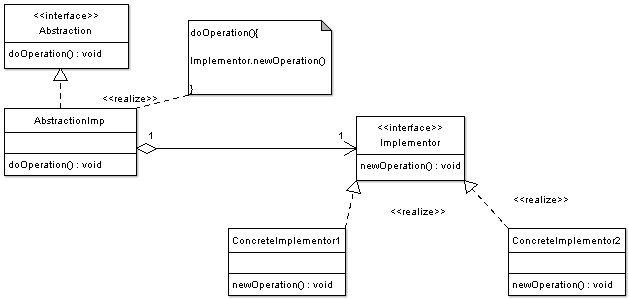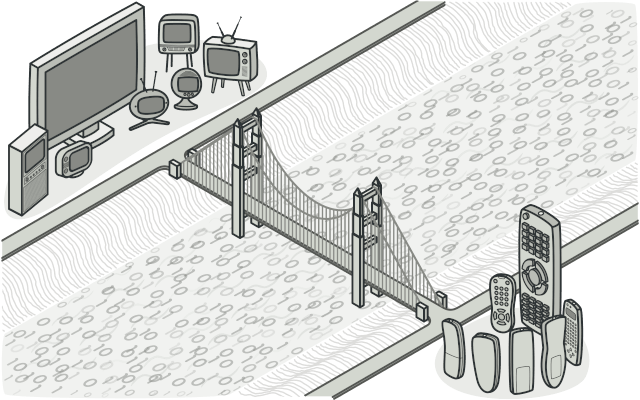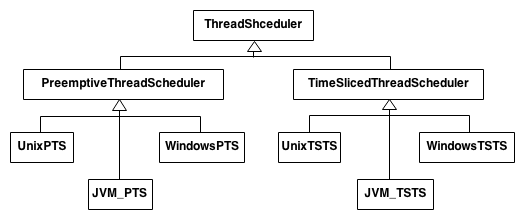Table Of Content

Decompose the component's interface and implementation into orthogonalclass hierarchies. The interface class contains a pointer tothe abstract implementation class. The clientinteracts with the interface class, and it in turn "delegates" allrequests to the implementation class. "Hardening of the software arteries" has occurred by using subclassingof an abstract base class to provide alternative implementations.
How do you implement the Bridge Design Pattern?
As a result, you can change the GUI classes without touching the API-related classes. Moreover, adding support for another operating system only requires creating a subclass in the implementation hierarchy. The previous version of the software called “DailyJournal” is not discarded yet, and the users can also access the pages on the previous version.
Design Patterns
You can find the code for all these examples at our Design pattern GitHub repository. The Client doesn't want to deal with platform-dependent details.The Bridge pattern encapsulates this complexity behind an abstraction"wrapper". Let’s say, we are designing an application that allows us to down and store files on any operating system. Use the Shape and DrawAPI classes to draw different colored circles. Then you can just add the payment gateway member to the payment modes. And at runtime pass this information to the payment mode object.
Some other Popular Design Patterns

The above change does not force you to make any changes in the implementor’s classes/interface. If you want to change Rectange class, then you may end up changing BlueRectangle and RedRectangle as well – and even if the change is color specific then you may need to change Circle classes as well. We get this decoupling by adding one more redirection between method calls from abstraction to implementation. Thus the Bridge design pattern in object-oriented programming is equivalent to normalisation to projection–join normal form, denoted PJ/NF (Fagin 1979), in relational databases. A classic example of the Bridge pattern is used in the definition of shapes in an UI environment (see the Bridge pattern Wikipedia entry).

The Bridge Pattern: Introduction
422904-2-52-01 I-275 (Howard Frankland Bridge) New southbound bridge between Pinellas and Hillsborough counties - FDOT Tampa Bay
422904-2-52-01 I-275 (Howard Frankland Bridge) New southbound bridge between Pinellas and Hillsborough counties.
Posted: Wed, 24 Jun 2020 02:30:49 GMT [source]
So, please modify the Main method of the Program class as shown below. First, we are using the SonyRemoteControl and attaching the SonyLedTv to access the Sony LED TV remote (i.e., Turn On, Change Channel, and Turn Off). We can also do the same thing using SamsungRemoteControl to access the SansungLedTv remote. Suppose you want to add a new implementation later, then you can do this in the Implementation Layer.
It is easy to learn and use and can make a big difference in the quality of your code. So, the next time you need to decouple abstraction and implementation, use the Bridge pattern to achieve the desired goal. You can use the Bridge design pattern to create a layer of abstraction between the user interface and the business logic. The Bridge can be helpful in cases where the user interface needs to be changed without affecting the business logic. To understand the definition of a Bridge Design Pattern, please look at the following image.
Example of Bridge Pattern
This is a design mechanism that encapsulates an implementation class inside of an interface class. The former (class) is the body, and the latter (interface) is the handle. The handle is viewed by the user as the actual class, but the work is done in the body. At first sight, the Bridge pattern looks a lot like the Adapter pattern in that a class is used to convert one kind of interface to another.
Using the SwitchOff method, we can turn Off the Sony TV, and using the SetChannel method, we can change the channel number of the Sony TV. Create a class file named SamsungLedTv.cs and copy and paste the following code. This class implements the LEDTV interface and provides implementations for SwitchOn, SwitchOff, and SetChannel methods. Using the SwitchOff method, we can turn Off the Samsung TV, and with the SetChannel method, we can change the channel number of the Samsung TV.
Spring Framework Guru
This class will have three abstract methods (SwitchOn, SwitchOff, and SetChannel). Here, you can give the method names the same as the ILEDTV interface, or you can also give different names. It has one protected variable, ledTv, which will be available to subclasses. The Bridge pattern allows changing or even creating new classes without touching the code of the opposite hierarchy.
When using subclassing, different subclasses implement an abstract class in different ways. But an implementation is bound to the abstraction at compile-time and cannot be changed at run-time. The bridge pattern is often confused with the adapter pattern, and is often implemented using the object adapter pattern; e.g., in the Java code below. Abstraction (also called interface) is a high-level control layer for some entity. It should delegate the work to the implementation layer (also called platform). Longer bridges are created by placing single spans next to each other, with modern beam bridges usually built from a combination of steel and reinforced concrete.
You should use the Bridge Design Pattern when you want to separate the abstraction and its implementation so that they can evolve independently. This pattern is useful when you have multiple implementations of the same interface or when you want to avoid the complexity of multiple inheritance. It can also be useful when you want to change the implementation of an abstraction at runtime. The Bridge pattern attempts to solve this problem by switching from inheritance to the object composition.
In this article, you will learn about the Bridge design pattern with examples and its practical implementation to solve real problems in software design. Remotes act as abstractions, and devices are their implementations. Thanks to the common interfaces, the same remotes can work with different devices and vice versa.
These hierarchies are then connected to each other via object composition, forming a bridge-like structure. The Bridge Design Pattern is a structural pattern that separates the abstraction and its implementation into separate class hierarchies. It allows the two hierarchies to evolve independently, without affecting each other.
Note the ease with which new colors and shapes can be added to the system without leading to an explosion of subclasses due to permutations. The explanation I've seen is that Adapter is used when you're trying to unify the interfaces of some incompatible classes that already exist. The Adapter functions as a kind of translator to implementations that could be considered legacy. Now, let's discuss how the Bridge design patterns can be used to solve the earlier discussed problem.
If we make any changes in the Implementation Layer, it won’t affect the Abstraction Layer. Similarly, if we make any changes in the Abstraction Layer, it won’t affect the Implementation layer. In this article, I will discuss the Bridge Design Pattern in C# with Examples.
Thislocks in compile-time binding between interface and implementation.The abstraction and implementation cannot be independently extended orcomposed. The Bridge Design Pattern is a structural pattern that decouples an abstraction from its implementation, allowing them to vary independently. This pattern is widely used in software development, and in this comprehensive guide, we will explore everything you need to know about it. You can bring order to this chaos by extracting the code related to specific interface-platform combinations into separate classes. However, soon you’ll discover that there are lots of these classes. The class hierarchy will grow exponentially because adding a new GUI or supporting a different API would require creating more and more classes.

No comments:
Post a Comment